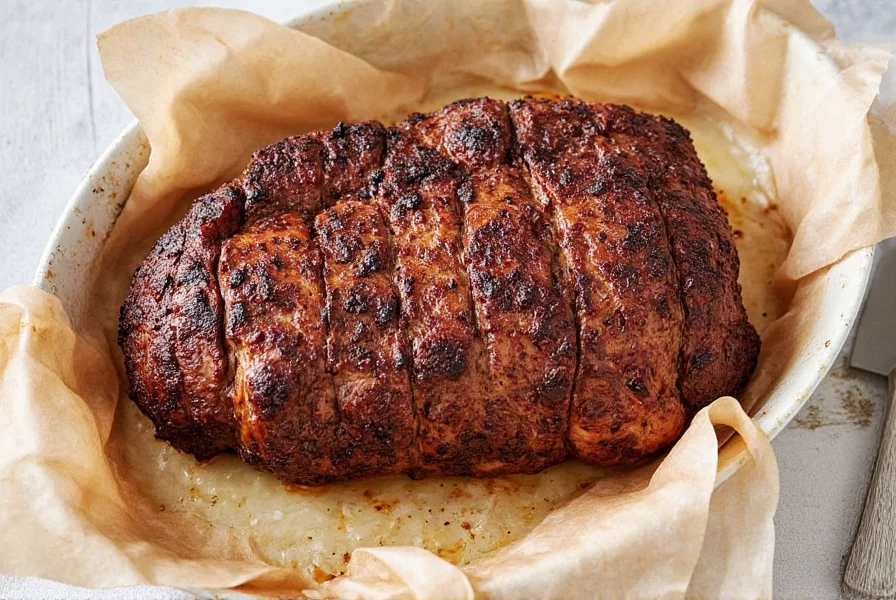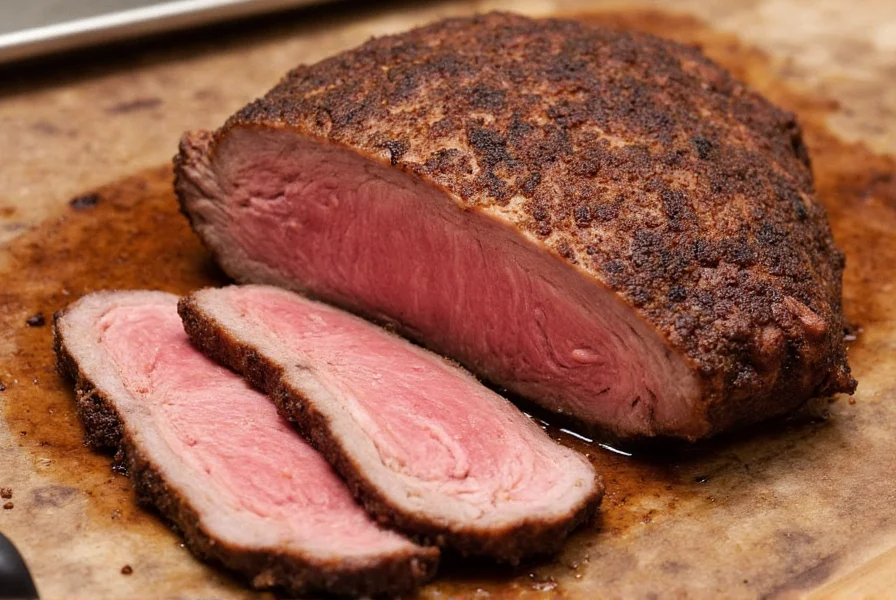If you're wondering how to bake brisket to perfection without specialized equipment, you're in the right place. Oven-baked brisket delivers that coveted tender, pull-apart texture many associate only with smoking. The key lies in understanding the meat's structure and applying consistent, low heat that breaks down tough connective tissues without drying out the meat.
Brisket comes from the lower chest of the cow and contains significant collagen that needs proper conversion to gelatin. This transformation happens slowly between 160-205°F (71-96°C), which is why low-temperature baking is essential. Unlike smoking, baking in the oven provides a controlled environment that's perfect for beginners while still delivering restaurant-quality results.
Essential Equipment for Baking Brisket
Before you start how to bake brisket in the oven, gather these tools:
- Heavy-duty roasting pan or Dutch oven with tight-fitting lid
- Meat thermometer (instant-read and leave-in probe)
- Sharp boning or chef's knife for trimming
- Butcher paper or aluminum foil
- Basting brush
- Cutting board with groove for juices
Selecting the Perfect Brisket
When learning how to make tender brisket in the oven, your starting point matters. Look for:
- Grade: USDA Choice or Prime (Prime has more marbling)
- Weight: 10-14 pounds is ideal for even cooking
- Appearance: Deep red color with even marbling throughout
- Thickness: Consistent thickness prevents uneven cooking
- Point vs. Flat: The flat cut is leaner and more uniform; the point has more fat and flavor

Preparing Your Brisket for Baking
Proper preparation is crucial for oven-baked brisket recipe for beginners. Follow these steps:
- Trim excess fat: Leave 1/4 inch of fat cap for moisture and flavor. Remove hard fat deposits.
- Season generously: Apply 1 tablespoon coarse salt and 2 tablespoons black pepper per pound. Add garlic powder, onion powder, or paprika if desired.
- Rest at room temperature: Let the seasoned brisket sit uncovered in the refrigerator for 1-24 hours, then bring to room temperature (1-2 hours) before baking.
The Baking Process: Temperature and Timing
Understanding best temperature for baking brisket is critical. The ideal range is 250-275°F (121-135°C). Higher temperatures risk drying out the meat, while lower temperatures extend cooking time unnecessarily.
| Brisket Weight | Temperature | Estimated Time | Target Internal Temp |
|---|---|---|---|
| 8-10 lbs | 275°F (135°C) | 8-10 hours | 195-205°F (90-96°C) |
| 10-12 lbs | 275°F (135°C) | 10-12 hours | 195-205°F (90-96°C) |
| 12-14 lbs | 275°F (135°C) | 12-14 hours | 195-205°F (90-96°C) |
Follow these baking steps for perfect results:
- Preheat oven to 275°F (135°C)
- Place brisket fat-side up in roasting pan
- Add 1-2 cups of beef broth or water to the pan bottom
- Cover tightly with lid or double layer of foil
- Insert probe thermometer into thickest part
- Bake until internal temperature reaches 195-205°F (90-96°C)
- Check temperature every hour after the 6-hour mark
When to Wrap Your Brisket
Many experienced cooks use the "Texas crutch" method when baking brisket. When the internal temperature reaches 160-170°F (71-77°C), the brisket enters the "stall" where temperature stops rising as moisture evaporates.
At this point, wrapping in butcher paper or foil can:
- Speed up cooking time by 25-30%
- Prevent excessive moisture loss
- Help break down connective tissues more efficiently
Butcher paper allows some breathability while foil creates a steamier environment. Choose based on your desired bark texture.
Testing for Doneness: Beyond Temperature
While temperature is important for how long to bake brisket at 275 degrees, doneness involves more than just numbers. Check these indicators:
- Probe test: A thermometer or skewer should slide in with almost no resistance
- Bend test: When lifted with tongs, the brisket should bend significantly in the middle
- Jiggle test: The surface should have a slight jiggle when shaken
The Critical Resting Period
Never skip resting when learning how to bake brisket perfectly. This 1-2 hour period allows:
- Juices to redistribute throughout the meat
- Residual heat to complete the cooking process
- Collagen to fully set into gelatin
Wrap the cooked brisket in a towel and place in an empty cooler or warm oven (turned off) to rest. This step transforms good brisket into exceptional brisket.

Slicing Technique for Perfect Results
How you slice determines your baking brisket without smoking success. Follow these guidelines:
- Identify the grain direction in both the flat and point sections
- For the flat cut: Slice across the grain into 1/4-inch strips
- For the point cut: Slice with the grain first, then across for burnt ends
- Use a sharp slicing knife and steady pressure
- Serve immediately while hot
Common Mistakes to Avoid
Avoid these pitfalls when mastering easy oven brisket cooking method:
- Rushing the process: Low and slow is essential—don't increase temperature to speed cooking
- Skipping the rest: Cutting too soon releases precious juices
- Incorrect slicing: Slicing with the grain creates tough, chewy pieces
- Over-trimming: Removing too much fat leads to dry brisket
- Opening the oven: Frequent checking causes temperature fluctuations
Variations and Serving Suggestions
Once you've mastered the basic how to bake brisket in the oven technique, try these variations:
- Marinade option: Soak brisket in beef broth, Worcestershire, and liquid smoke for 12 hours before seasoning
- Dry rub variations: Add coffee, cocoa powder, or chipotle for depth
- Glaze finish: Apply barbecue sauce during the last hour of cooking
- Serving: Pair with classic sides like coleslaw, baked beans, and cornbread
Frequently Asked Questions
How long does it take to bake a 12-pound brisket at 275°F?
A 12-pound brisket typically requires 12-14 hours at 275°F. The exact time depends on your oven's accuracy and the brisket's thickness. Always use internal temperature (195-205°F) as your primary doneness indicator rather than time alone.
Should I wrap my brisket when baking in the oven?
Yes, wrapping at 160-170°F (the stall phase) is recommended. Use butcher paper for a balance of moisture retention and bark development, or foil for faster cooking and more tender results. This technique, called the Texas crutch, helps overcome evaporative cooling and speeds up the cooking process.
Why is my baked brisket tough even after reaching 200°F?
Tough brisket at proper temperature usually indicates insufficient cooking time at that temperature. The collagen needs sustained heat to fully convert to gelatin. Continue cooking until the probe test shows no resistance. Also ensure you're not slicing with the grain and that you've allowed proper resting time before slicing.
Can I bake brisket without a thermometer?
While possible, baking brisket without a thermometer is not recommended. Temperature monitoring is critical for proper doneness. The meat must reach 195-205°F internally for tender results, which cannot be accurately judged by time alone. An inexpensive instant-read thermometer is essential equipment for successful brisket baking.










 浙公网安备
33010002000092号
浙公网安备
33010002000092号 浙B2-20120091-4
浙B2-20120091-4